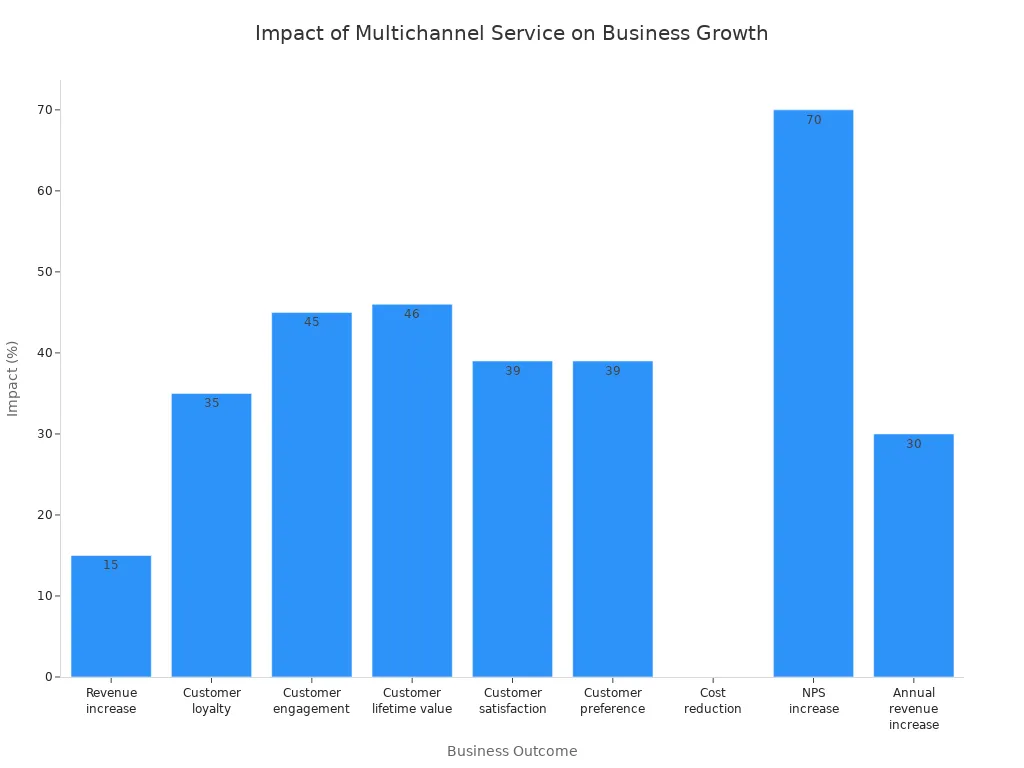Unlocking Growth with Multichannel Customer Service Solutions

Multichannel customer service now drives measurable business growth in 2025. Companies embracing unified customer contact and seamless experiences see revenue rise by up to 15% and customer retention jump 90%. 
A multi-channel approach, powered by advanced AI and automation, allows organizations to anticipate needs and resolve issues faster. Sobot AI leverages these technologies, helping brands deliver consistent, personalized support across every touchpoint. Companies should now ask if their current systems meet future customer expectations for intelligent, seamless service.
- Unified customer contact integrates all touchpoints for a frictionless experience, fostering loyalty.
- Seamless experiences reduce complexity, enabling faster resolution with AI and chatbots.
- CRM and data analytics anticipate needs, boosting satisfaction.
- A strong strategy sets brands apart and drives long-term success.
Multichannel Customer Service

Definition
Multichannel customer service means providing support and communication through several channels at the same time. Companies use a multi-channel approach to connect with customers on platforms like phone, email, live chat, social media, and messaging apps. This strategy helps businesses meet customers where they are most comfortable. Sobot, for example, offers a unified workspace that brings together all these channels, making it easier for agents to manage conversations and deliver fast responses. A strong multi-channel strategy forms the foundation for both customer support and multi-channel marketing, ensuring every interaction is tracked and managed efficiently.
Key Benefits
A well-designed multi-channel strategy brings many advantages:
- Customers stay loyal and return more often. HubSpot reports that 93% of customers make repeat purchases from companies with excellent service.
- Businesses save money and work more efficiently. Self-service options like chatbots and FAQs handle many questions, so companies do not need to hire as many agents.
- Companies learn more about their customers. Tracking interactions across channels gives valuable insights, helping teams personalize support and multi-channel marketing campaigns.
Sobot’s multi-channel solutions use AI and automation to boost efficiency and provide a seamless experience. This approach supports both customer service and multi-channel marketing, making it easier to reach and engage customers at every stage.
Customer Expectations
In 2025, customers expect a smooth journey across every channel. They want to switch from chat to phone or email without repeating themselves. Speed matters—45% want their issues solved in the first contact, and 46% expect a reply within four hours. Many prefer self-service for simple problems, but most still value human help for complex issues. Personalization is key, as customers want companies to remember their preferences and needs. Data privacy and clear communication about data use are also top priorities. A successful multi-channel strategy must blend AI efficiency with human empathy, meeting these high expectations for both service and multi-channel marketing.
Growth Impact
Customer Satisfaction
Multichannel customer service plays a key role in raising customer satisfaction. Research shows that when companies offer support through both traditional and digital channels, customers feel more satisfied. They enjoy more convenience, save time, and trust the service more. For example, a study with a large retail bank found that customers who could use both branch offices and online banking reported higher satisfaction rates. These channels work together to meet different needs. For routine questions, digital tools like chatbots help quickly. For complex issues, human agents step in. This balanced strategy ensures customers always get the right help at the right time. Companies that use this approach see better customer satisfaction and stronger relationships.
Loyalty and Revenue
A strong multichannel strategy does more than improve service—it builds loyalty and drives revenue growth. Customers who receive support across many channels stay loyal to brands. They buy more often, share positive feedback, and are less likely to switch to competitors. Research confirms that offering a wide mix of service options, such as live chat, phone, and messaging apps, leads to higher loyalty. Loyal customers help companies grow by making repeat purchases and recommending the brand to others. This strategy also acts as a shield in competitive markets, keeping customers from leaving. As loyalty grows, so does revenue, making multichannel customer service a smart investment for any business.
- Multichannel service increases convenience and product selection.
- Satisfied customers show stronger loyalty and buy more often.
- Loyalty protects brands from losing customers to rivals.
- Investments in multiple channels lead to higher profits.
Sobot Case Study
Sobot’s partnership with Opay shows the real-world impact of a multichannel strategy. Opay, a leading financial platform, faced challenges managing customer interactions across social media, email, and voice calls. By adopting Sobot’s omnichannel solution, Opay unified all channels into one system. This move raised customer satisfaction from 60% to 90%. Operational costs dropped by 20%, and conversion rates increased by 17%. Sobot’s AI-powered tools, like chatbots and intelligent IVR, allowed Opay to handle high volumes of inquiries and offer self-service options. The WhatsApp Business integration achieved an 85% message reading rate, boosting marketing results. This case highlights how Sobot’s strategy delivers measurable growth, efficiency, and customer satisfaction for modern businesses.
Sobot’s multichannel solutions provide 24/7 support, automate tasks, and integrate with business tools. Companies gain analytics-driven insights and proactive issue resolution, making the strategy flexible for any industry.
Customer Behavior
Journey Mapping
Customer journey mapping gives companies a clear, data-driven view of how people interact with brands across every channel. Unlike simple customer profiles, journey maps show real actions, feelings, and pain points at each step. Teams use analytics, interviews, and feedback to build these maps. This process helps companies spot where customers get stuck or frustrated. With this knowledge, businesses can improve content, channel use, and every part of the multi-channel experience. For example, Sobot’s unified workspace lets agents see the full journey, making it easier to solve problems quickly. When teams from marketing, customer service, and tech work together, they can fix issues faster and create a smoother, more personal multi-channel path for every customer.
Companies that use journey mapping see higher conversions and better retention. Multi-channel strategies built on journey maps help brands meet real needs and remove barriers.
Channel Preferences
Customers today want flexibility. They expect to move between channels like phone, chat, email, and social media without repeating themselves. Research shows that 28% of people see multiple ways to communicate as essential. Multi-channel options let customers pick what works best for them. Some prefer live chat for quick answers, while others want to talk to a real person for complex issues. Sobot’s platform supports all these choices, making sure every message and call is tracked in one place. This approach keeps the experience smooth and consistent, no matter which channel customers use.
| Channel | Preferred Use Case | Customer Expectation |
|---|---|---|
| Phone | Complex issues | Personal attention |
| Live Chat | Quick questions | Fast response |
| Detailed support | Clear follow-up | |
| Social Media | Public feedback | Instant engagement |
Audience Segmentation
Not all customers act the same way. Audience segmentation breaks customers into groups based on behavior, needs, or channel use. This helps companies send the right message at the right time. For example, some users may only use mobile apps, while others prefer email or social media. Multi-channel communication strategies use this data to personalize support and marketing. Sobot’s analytics tools help businesses spot these groups and adjust their approach. By understanding each segment, companies can offer targeted help, boost satisfaction, and increase loyalty. Segmentation also supports remarketing and automation, making every multi-channel interaction more effective.
Unified Service Approach
Technology Integration

Companies today need seamless technology integration to deliver true omnichannel support. Sobot’s Voice/Call Center and omnichannel solution make this possible by connecting phone, chat, email, and social media into one unified workspace. This integration gives agents a 360° view of every customer, so they can respond quickly and accurately. Leading platforms use automation to unify customer data, automate journeys, and trigger personalized messages. Sobot’s ai-powered tools help automate routine tasks, freeing agents to focus on complex issues. With omnichannel support, businesses can map the customer journey, identify pain points, and optimize every touchpoint. This approach ensures that customers receive consistent, connected service, no matter which channel they choose.
- Marketing automation platforms enable real-time data integration and dynamic segmentation.
- Intelligent virtual agents use ai to streamline interactions and reduce manual work.
- Unified systems allow for fast, efficient omnichannel support across all channels.
Brand Consistency
Brand consistency builds trust and loyalty. Technology integration plays a key role by consolidating all customer interactions into a single platform. Sobot’s omnichannel support ensures that agents have access to full customer histories, so every interaction feels personal and seamless. When companies use integrated systems, agents can pick up conversations where others left off, reducing customer frustration. Studies show that 75% of customers will spend more with brands that offer a consistent experience (source). Omnichannel support, powered by ai, synchronizes every touchpoint and keeps messaging clear and on-brand. This unified approach also helps companies gather insights to improve marketing and service strategies.
Consistent service across all channels increases satisfaction and strengthens brand loyalty.
| Benefit | Impact on Brand |
|---|---|
| Unified customer data | Seamless experience |
| ai-driven automation | Faster responses |
| Omnichannel support | Stronger loyalty |
Team Training
A unified service approach depends on well-trained teams. Companies see better results when they set clear goals, define roles, and encourage open communication. Sobot supports team training by providing easy-to-use tools and dashboards that help agents learn quickly. Team leaders play an active role in sharing company goals and recognizing teamwork. Public recognition programs boost motivation and engagement. Documenting responsibilities and making them accessible helps everyone stay aligned. With ongoing training and support, teams deliver high-quality omnichannel support and use ai tools effectively. This leads to faster problem resolution and higher customer satisfaction.
- Define team goals and roles for clarity.
- Encourage open feedback and communication.
- Involve leaders in sharing company vision.
- Recognize teamwork and celebrate success.
- Document responsibilities for easy access.
Data and Analytics

Centralized Data
Centralized data forms the backbone of effective multichannel customer service. Companies that unify customer information across all channels prevent customers from repeating themselves, which increases satisfaction and loyalty. A unified view of every interaction streamlines management and analysis, making it easier for teams to deliver a smooth, personalized experience. Centralization also boosts operational efficiency by enabling automated responses and freeing agents to focus on complex issues.
- Centralized customer data prevents repetition and improves satisfaction.
- A unified view streamlines management and analysis.
- Centralization supports smooth, personalized experiences.
- Automation becomes easier, improving efficiency.
- Every interaction counts, building loyalty.
Recent studies show that 78% of companies use centralized data as part of their multichannel customer service strategy. Larger organizations see even greater benefits, with 64% reporting improved efficiency and 57% noting business growth. Sobot’s omnichannel solution brings all customer data into one workspace, helping businesses break down silos and support advanced analytics for better decision-making.
Insights and Optimization
Analytics play a vital role in optimizing multichannel customer service. Companies use data to make informed decisions, not guesses. By integrating information from web analytics, social media, email, and CRM systems, businesses gain a complete picture of customer behavior and preferences. This approach improves targeting, personalization, and segmentation.
- Analytics support informed decisions based on real data.
- Integration of multiple sources provides comprehensive insights.
- Channel-specific analysis identifies the most effective platforms.
- Continuous monitoring and testing drive ongoing improvements.
- Data-driven practices optimize customer journeys and business outcomes.
Sobot’s platform offers real-time analytics and reporting, allowing teams to track performance and adjust strategies quickly. Businesses can see which channels work best, allocate resources wisely, and improve both customer experience and marketing effectiveness.
Privacy and Security
Protecting customer data remains a top priority in multichannel customer service. Companies must encrypt data both at rest and in transit to prevent unauthorized access. Role-based access control limits who can view sensitive information. Regular audits help identify vulnerabilities and ensure compliance with privacy laws. Clear privacy policies across all channels build trust with customers. Ongoing staff training ensures everyone understands data protection and breach response.
Tip: Companies that follow these best practices not only protect customer information but also strengthen their reputation and customer trust.
Sobot’s solutions use encrypted data transfer and strict access controls, supporting secure and compliant multichannel customer service for businesses of all sizes.
Multichannel Challenges
Channel Silos
Channel silos create major obstacles for companies using a multi-channel approach. When each channel operates alone, teams cannot share customer data or insights. This leads to several problems:
- Employees struggle to manage conversations across different channels.
- Customers must repeat information and verify their identity multiple times.
- Experiences become inconsistent, causing frustration.
- Case handling takes longer because information is scattered.
- Opportunities for cross-selling and upselling are missed due to fragmented data.
- The overall customer experience and business results suffer.
A unified platform, like Sobot’s omnichannel solution, connects all channels and centralizes data. This integration helps teams deliver a seamless multi-channel experience and supports both customer service and multi-channel marketing efforts.
Resource Management
Managing resources across a multi-channel environment requires careful planning. Leading companies connect every channel to a central data system. This ensures both AI and human agents have full context for each customer. They use advanced AI agents to handle routine questions, which allows human agents to focus on complex cases. AI tools also suggest replies and summarize cases, making work easier for teams.
Companies test and select channels based on customer preferences. They use self-service portals, live chat, SMS, voice, and email to meet different needs. Regular reviews of analytics and knowledge bases keep self-service options effective. Integration with sales and marketing functions enables a unified multi-channel marketing strategy. Chat reduces call volumes, while voice channels remain vital for complex issues. Messaging apps and email provide reliable support and improve response times.
Actionable Solutions
Companies can overcome multi-channel challenges by following these steps:
- Develop a unified marketing strategy that keeps messaging consistent but adapts to each channel’s style.
- Use AI and machine learning to automate tasks and provide 24/7 support, such as chatbots for multi-channel marketing.
- Track engagement and performance with analytics tools to make data-driven decisions.
- Personalize experiences by tailoring messages and offers based on customer data.
- Ensure omnichannel integration so customers can move between channels without losing progress.
- Train teams regularly to use tools and strategies effectively.
- Gather customer feedback to refine the multi-channel approach and improve service quality.
Sobot’s all-in-one contact center supports these solutions by offering unified workspaces, AI-powered automation, and advanced analytics. This helps businesses deliver a seamless multi-channel experience and drive growth through effective multi-channel marketing.
Multi-Channel Marketing Strategy
A strong multi-channel marketing strategy helps businesses connect with customers at every stage of their journey. Companies use this approach to deliver personalized customer experiences, improve customer engagement, and drive growth. Sobot’s solutions support effective multi-channel marketing by unifying communication channels, automating outreach, and providing advanced analytics.
Personalization
Personalization stands at the heart of every successful multi-channel marketing strategy. Companies use data analytics to tailor messages, product recommendations, and offers based on customer behavior and preferences. This approach creates personalized customer experiences that boost engagement and loyalty. For example, Sobot’s platform gathers data from all channels, allowing businesses to recognize customer needs and deliver relevant content. Personalized customer experiences increase satisfaction and drive repeat business. Consistent messaging across channels also strengthens brand identity and trust, leading to higher conversion rates.
- Personalization delivers relevant content, such as emails and product suggestions.
- Unified data enables businesses to engage customers at the right time and place.
- Consistent experiences across channels support long-term growth.
Self-Service Options
Self-service options play a key role in any multi-channel marketing strategy. Customers want quick answers and the ability to solve simple issues on their own. Sobot’s AI-powered chatbots and knowledge bases provide 24/7 support, improving first-contact resolution. These tools help businesses offer personalized customer experiences while reducing agent workload. Self-service features also support effective multi-channel marketing by making information accessible across platforms, from websites to messaging apps.
Tip: Companies that offer self-service options see higher satisfaction and lower support costs.
Expanding Reach
A multi-channel marketing strategy expands a company’s reach by connecting with customers on their preferred platforms. Businesses use social media, email, websites, mobile apps, and SEO to increase visibility and adapt to changing trends. Sobot’s omnichannel solution supports global communication, offering multi-language and multi-timezone management. This flexibility allows brands to engage diverse audiences and maintain consistent messaging. Companies also use AI and automation to optimize campaigns and deliver timely, personalized interactions. By diversifying channels, businesses reduce risk and ensure business continuity.
| Channel | Benefit |
|---|---|
| Social Media | Broad audience reach |
| Personalized campaigns | |
| Website | Central information hub |
| Mobile App | Direct customer access |
A well-executed multi-channel marketing strategy ensures that every touchpoint delivers value, supporting both customer engagement and business growth.
Industry leaders recommend four key strategies for unlocking growth: cross-channel integration, automation and personalization, analytics, and seamless customer enablement. Companies using a multi-channel approach see higher customer satisfaction and retention. Sobot’s unified, customer-centric platform empowers teams to deliver fast, personalized support and optimize every touchpoint. Businesses that adopt a multi-channel approach with advanced tools like Sobot achieve measurable gains in efficiency and ROI. Explore how Sobot can transform multichannel customer service for your organization.
FAQ
What is multichannel customer service?
Multichannel customer service means companies help customers on many platforms, like phone, email, chat, and social media. Sobot’s solutions unify these channels, making it easier for agents to respond quickly and keep service consistent.
How does Sobot improve multichannel customer service?
Sobot provides an all-in-one contact center. It connects phone, chat, email, and messaging apps in one workspace. Agents see every customer’s history, which helps them solve problems faster and deliver seamless multichannel customer service.
Why do businesses need a multichannel customer service solution?
Customers expect fast, personalized help on their favorite channels. Research shows 93% of customers return to brands with great service (source). Multichannel customer service solutions like Sobot help companies meet these high expectations.
Can Sobot’s multichannel customer service support global teams?
Yes. Sobot’s platform supports global numbers, multiple languages, and time zones. This makes multichannel customer service easy for international teams and helps businesses reach customers worldwide.
What results can companies expect from using Sobot’s multichannel customer service?
Companies using Sobot’s multichannel customer service solutions often see higher customer satisfaction, lower costs, and better efficiency. For example, Opay increased satisfaction from 60% to 90% and cut costs by 20% after adopting Sobot.
See Also
A Complete Guide To Deploying Omnichannel Contact Centers
Essential Tips For Choosing Omnichannel Call Center Software
Effective Live Chat Techniques To Enhance SaaS Customer Support
Ways Ecommerce Live Chat Tools Increase Online Sales Revenue
